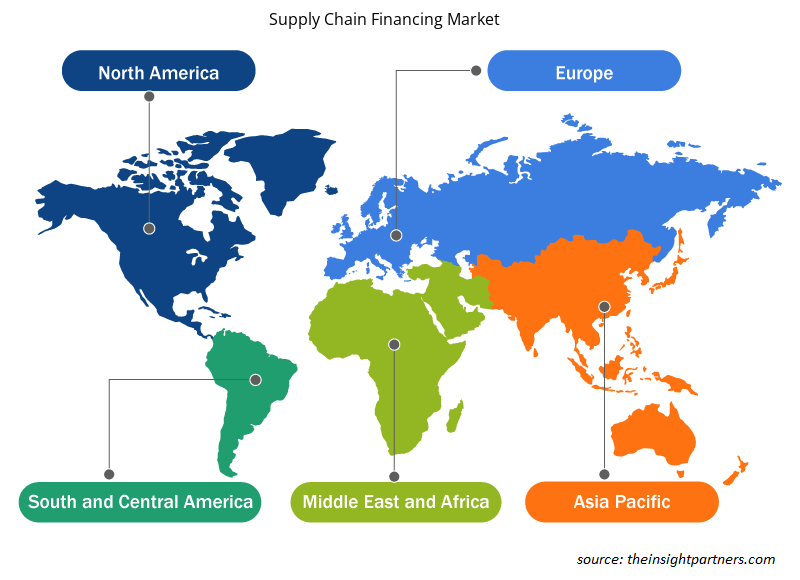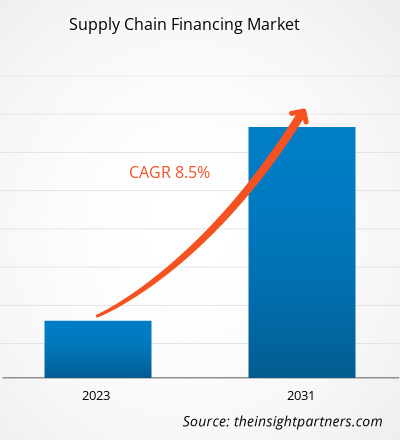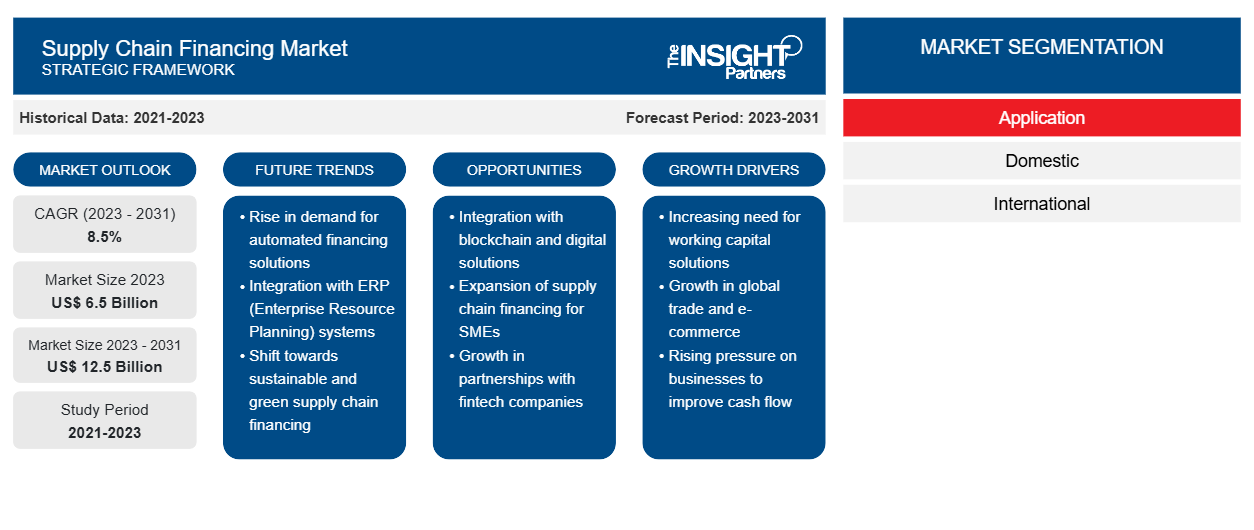공급망 금융 시장 규모는 2023년 65억 달러에서 2025년 100억 달러로 성장할 것으로 예상됩니다. 2031년까지 125억 달러에 달할 것으로 예상되며, 2023년부터 2031년까지 연평균 성장률 8.5%로 성장할 것으로 예상됩니다. 이 산업의 시장 성장은 자금 조달 비용 절감, 효율성 향상, 세계화 및 공급망 위험, 운전 자본 관리에 대한 필요성 증가 등 다양한 요인에 의해 주도되고 있습니다.
공급망 자금 조달 시장 분석
공급망 금융 시장을 주도하는 요인은 여러 가지가 있습니다. 첫째, 공급 활동에서 안전과 보안에 대한 필요성이 커지고 있으며, 이로 인해 공급망 금융 솔루션에 대한 수요가 증가했습니다. 안전과 보안에 대한 이러한 필요성은 혼란과 불확실성이 흔한 현재의 비즈니스 환경에서 특히 두드러집니다. 둘째, 개발도상국의 중소기업(SME)이 공급망 금융을 도입하면서 시장 성장에 기여하고 있습니다. 중소기업은 공급망 금융이 재무 운영을 개선하고 경쟁력을 강화하는 데 도움이 된다는 것을 인식하고 있습니다.
귀하의 요구 사항에 맞게 이 보고서를 사용자 정의하세요
이 보고서의 일부 또는 국가 수준 분석, Excel 데이터 팩을 포함하여 모든 보고서에 대한 사용자 정의를 무료로 받을 수 있으며 신생 기업 및 대학을 위한 훌륭한 혜택과 할인 혜택을 이용할 수 있습니다.
- 이 보고서의 주요 시장 동향을 알아보세요.이 무료 샘플에는 시장 동향부터 추정 및 예측까지 다양한 데이터 분석이 포함됩니다.
공급망 금융 산업 개요
- 공급망 금융은 공급업체 금융 또는 역팩토링이라고도 하며, 공급망 활동에 참여하는 기업의 현금 흐름과 운전 자본을 최적화하는 금융 솔루션입니다.
- 구매자, 공급자, 금융 기관을 연결하여 자금 조달 비용을 낮추고, 현금 흐름 효율성을 개선하고, 위험을 줄이는 일련의 기술 기반 프로세스를 포함합니다. 공급망 금융에서 구매자는 일반적으로 판매자보다 신용 등급이 높아 금융 제공자로부터 더 낮은 비용으로 자본에 접근할 수 있습니다.
- 이러한 이점을 통해 구매자는 판매자와 연장된 지불 일정과 같은 더 나은 조건을 협상할 수 있습니다. 한편, 판매자는 중개 금융 기관으로부터 즉시 지불을 받아 제품을 더 빨리 하역할 수 있습니다. 공급망 금융의 목표는 구매자와 판매자 모두에게 단기 신용을 제공하고 작업 자본을 최적화하는 것입니다. 공급업체가 송장에 대한 조기 지불을 받아 공급망 중단 위험을 줄이고 재정적 안정성을 개선하는 데 도움이 됩니다. 구매자는 작업 자본이 증가하고 공급업체와의 관계를 강화할 수 있는 이점이 있습니다.
공급망 금융 시장 동인
공급망 금융 시장을 주도하는 공급 활동의 안전 및 보안에 대한 필요성 증가
- 공급망 금융 시장 성장을 주도하는 주요 요인은 여러 가지가 있습니다. 무엇보다도 안전과 보안에 대한 필요성의 증가가 공급망 금융 시장 성장의 확대에 기여하고 있습니다.
- 공급망 금융에 대한 수요는 시장 조작으로 인해 증가하고 있으며, 여기에는 투자자 신뢰 상실, 시장 무결성 손상, 사기 행위, 더 나은 데이터 수집, 모니터링 기능 및 재정적 보안을 제공하는 공급망 금융 접근 방식에 투자하라는 금융 회사에 대한 압력 등이 포함됩니다. 국제 무역의 초기에 수출업체는 수입업체가 상품에 대한 비용을 지불할지 여부에 대한 불확실성에 직면했습니다.
- 반면, 수입업체는 상품이 선적된다는 보장 없이 지불하는 것에 대해 우려했습니다. 공급망 금융은 수출업체에 더 빠른 지불을 제공하고 신용장을 통해 수입업체를 보장함으로써 이러한 위험을 해결하기 위해 발전했습니다. 경쟁자보다 앞서 나가기 위해 공급망 금융 제공업체는 투자자 인터페이스 경험을 향상시키기 위한 더 많은 솔루션을 도입하고 있습니다. 공급망 활동에서 안전과 보안에 대한 이러한 집중이 증가함에 따라 공급망 금융 시장 전망에 새로운 기회가 생길 것으로 예상됩니다.
공급망 자금 조달 시장 보고서 세분화 분석
제공을 기준으로 공급망 자금 조달 시장은 다음과 같이 세분화됩니다.수출입 어음, 신용장, 이행 보증, 선적 보증 등. 수출입 어음 부문은 2023년에 상당한 공급망 금융 시장 점유율을 차지할 것으로 예상됩니다. 이는 은행이 공급업체에 대한 문서 및 지불의 이동을 용이하게 하는 역할에 기인할 수 있습니다. 무역 금융의 맥락에서 징수를 위한 수출 어음은 수출자가 은행에 접근하여 문서의 이동과 해제를 제어하는 방법입니다. 수출자는 종종 수입자로부터 미지불 위험에 직면하는 반면, 수입자는 상품이 선적될 것이라는 보장 없이 지불하는 것에 대해 우려합니다. 특히 수출 어음을 사용하여 공급망 금융은 수출자에게 지불을 가속화하고 신용장(LOC)을 통해 수입자를 보장함으로써 이러한 위험을 해결합니다. 따라서 국제 무역 활동에서 안전과 보안에 대한 필요성이 증가함에 따라 새로운 공급망 금융 시장 트렌드가 나타날 것으로 예상됩니다.
지역별 공급망 자금 조달 시장 분석
공급망 금융 시장 보고서의 범위는 주로 북미, 유럽, 아시아 태평양, 중동 및 아프리카, 남미의 5개 지역으로 나뉩니다. 북미는 급속한 성장을 경험하고 있으며 상당한 공급망 금융 시장 점유율을 차지할 것으로 예상됩니다. 기업 재무와 공급망 위험에 대한 세계화의 영향이 심화되어 공급망 금융 솔루션에 대한 수요가 증가했습니다. 또한 원격 근무와 사회적 거리두기의 증가로 인해 공급망 금융은 여러 위치와 소스에서 데이터를 수집하는 데 어려움을 겪었습니다. 이는 위험을 완화하고 원활한 운영을 보장하기 위해 강력한 공급망 금융 솔루션의 중요성을 강조했습니다.
공급망 금융 시장 지역 통찰력
Insight Partners의 분석가들은 예측 기간 동안 공급망 자금 조달 시장에 영향을 미치는 지역적 추세와 요인을 철저히 설명했습니다. 이 섹션에서는 북미, 유럽, 아시아 태평양, 중동 및 아프리카, 남미 및 중미의 공급망 자금 조달 시장 세그먼트와 지리적 분포도 논의합니다.

- 공급망 금융 시장을 위한 지역별 특정 데이터 얻기
공급망 금융 시장 보고서 범위
| 보고서 속성 | 세부 |
|---|---|
| 2023년 시장 규모 | 65억 달러 |
| 2031년까지 시장 규모 | 125억 달러 |
| 글로벌 CAGR (2023-2031) | 8.5% |
| 역사적 데이터 | 2021-2023 |
| 예측 기간 | 2023-2031 |
| 다루는 세그먼트 | 응용 프로그램으로
|
| 포함된 지역 및 국가 | 북아메리카
|
| 시장 선도 기업 및 주요 회사 프로필 |
|
공급망 금융 시장 참여자 밀도: 비즈니스 역학에 미치는 영향 이해
공급망 금융 시장 시장은 소비자 선호도의 변화, 기술 발전, 제품의 이점에 대한 인식 증가와 같은 요인으로 인해 최종 사용자 수요가 증가함에 따라 빠르게 성장하고 있습니다. 수요가 증가함에 따라 기업은 제품을 확장하고, 소비자의 요구를 충족하기 위해 혁신하고, 새로운 트렌드를 활용하여 시장 성장을 더욱 촉진하고 있습니다.
시장 참여자 밀도는 특정 시장이나 산업 내에서 운영되는 회사나 기업의 분포를 말합니다. 주어진 시장 공간에 얼마나 많은 경쟁자(시장 참여자)가 존재하는지 그 규모나 총 시장 가치에 비해 나타냅니다.
공급망 자금조달 시장에서 운영되는 주요 회사는 다음과 같습니다.
- HSBC 그룹
- 로열 뱅크 오브 스코틀랜드 주식회사
- 시티그룹 주식회사
- JP모건 체이스 앤 코.
- 뱅크 오브 아메리카 주식회사
면책 조항 : 위에 나열된 회사는 어떤 특별한 순서에 따라 순위가 매겨지지 않았습니다.

- 공급망 금융 시장 주요 주요 업체 개요를 알아보세요
"공급망 금융 시장 분석"제공, 제공자, 애플리케이션 및 지리에 따라 수행되었습니다. 제공 측면에서 시장은 수출입 어음, 신용장, 이행 보증, 선적 보증 및 기타로 세분화됩니다. 제공자를 기준으로 시장은 은행, 거래 금융 회사 및 기타로 세분화됩니다. 애플리케이션별로 시장은 국내 및 국제로 세분화됩니다. 지리를 기준으로 시장은 북미, 유럽, 아시아 태평양, 중동 및 아프리카, 남미로 세분화됩니다.
공급망 금융 시장 뉴스 및 최근 개발
기업들은 공급망 금융 시장에서 합병 및 인수와 같은 무기적 및 유기적 전략을 채택합니다. 최근 몇 가지 주요 시장 개발은 다음과 같습니다.
- 2023년 8월, HSBC는 새로운 합작 회사를 설립하려는 계획의 일환으로 공급망 금융 회사인 Tradeshift에 3,500만 달러의 전략적 투자를 했습니다.이 합작 투자는 내장형 금융 서비스 개발에 집중할 것입니다.이 투자는 HSBC와 다른 투자자로부터 최소 7,000만 달러를 모금할 것으로 예상되는 대규모 자금 조달 라운드의 일부입니다.HSBC와 Tradeshift의 협업은 Tradeshift 플랫폼과 다른 플랫폼에 통합될 다양한 디지털 솔루션을 만드는 것을 목표로 합니다.이러한 솔루션에는 무역, 전자 상거래 및 마켓플레이스 경험에 내장된 지불 및 핀테크 서비스가 포함됩니다.이 합작 투자를 통해 Tradeshift는 비즈니스 상거래 제안을 전 세계적으로 확장하는 동시에 HSBC가 다양한 플랫폼에서 혁신적인 금융 서비스를 배포할 수 있게 됩니다.
(출처: HSBC, 회사 홈페이지)
- 2023년 9월, HSBC는 Alibaba Group의 물류 부문인 Cainiao Network Technology와 파트너십을 맺어 온라인 상인을 위한 혁신적인 디지털 무역 금융 솔루션을 출시했습니다. 이 협업은 Alibaba가 소유한 TMall Global e-marketplace에서 판매하는 홍콩 상인에게 간소화되고 접근 가능한 무역 금융 프로세스를 제공하는 것을 목표로 합니다. 이 새로운 제도는 신용 평가를 위해 실시간 물류 정보를 활용하여 더 빠르고 효율적인 대출 승인을 가능하게 합니다. 담보나 광범위한 재무 문서가 필요한 기존의 무역 금융 프로세스와 달리, 이 솔루션은 고객 배경, 실시간 재고, 운영 상태를 포함하여 Cainiao에서 제공하는 포괄적인 정보를 활용하여 신용도를 평가합니다. HSBC가 무역 금융 대출 승인을 위해 타사 데이터를 활용하는 것은 이번이 처음입니다.
(출처: HSBC, 회사 홈페이지)
공급망 금융 시장 보고서 범위 및 제공물
시장 보고서 "공급망 자금 조달 시장 규모 및 예측(2021-2031)"은 아래 영역을 포괄하는 시장에 대한 자세한 분석을 제공합니다.
- 범위에 포함된 모든 주요 시장 부문에 대한 글로벌, 지역 및 국가 수준의 시장 규모와 예측입니다.
- 시장 역학에는 동인, 제약, 주요 기회 등이 있습니다.
- 주요 미래 트렌드
- 자세한 PEST 및 SWOT 분석
- 주요 시장 동향, 주요 업체, 규정, 최근 시장 개발 사항을 다루는 글로벌 및 지역 시장 분석입니다.
- 시장 집중도, 히트맵 분석, 주요 업체 및 최근 개발 사항을 포괄하는 업계 환경 및 경쟁 분석입니다.
- 자세한 회사 프로필
- 과거 분석(2년), 기준 연도, CAGR을 포함한 예측(7년)
- PEST 및 SWOT 분석
- 시장 규모 가치/거래량 - 글로벌, 지역, 국가
- 산업 및 경쟁 환경
- Excel 데이터세트
최근 보고서
사용 후기
구매 이유
- 정보에 기반한 의사 결정
- 시장 역학 이해
- 경쟁 분석
- 고객 인사이트
- 시장 예측
- 위험 완화
- 전략 기획
- 투자 타당성 분석
- 신흥 시장 파악
- 마케팅 전략 강화
- 운영 효율성 향상
- 규제 동향에 발맞춰 대응























 무료 샘플 받기 - 공급망 금융 시장
무료 샘플 받기 - 공급망 금융 시장